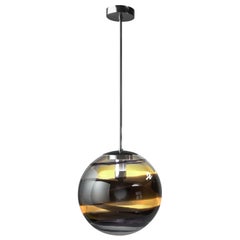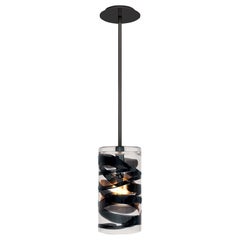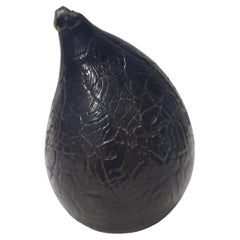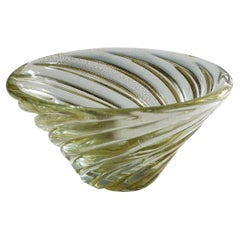Peter Marino Glass
3
to
3
3
3
3
3
3
3
3
85
208
137
129
127
Creator: Peter Marino
Murano Blown Glass Contemporary Pendant Light Design by Peter Marino for Venini
By Peter Marino, Venini
Located in murano, IT
ROTONDO 893.50
Peter Marino’s work is notoriously provocative. The Rotondo, Cilindro, and Parallelo lamps are no exception: using the “Fasce” technique, the artist hot-works coloure...
Category
21st Century and Contemporary Italian Modern Peter Marino Glass
Materials
Blown Glass, Murano Glass
Murano blown glass contemporary pendant light design by Peter Marino for VENINI
By Peter Marino, Venini
Located in murano, IT
PARALLELO 893.76
Peter Marino’s work is notoriously provocative. The Rotondo, Cilindro, and Parallelo lamps are no exception: using the “Fasce” technique, the artist hot-works colour...
Category
21st Century and Contemporary Italian Modern Peter Marino Glass
Materials
Blown Glass, Murano Glass
Murano Blown Glass Contemporary Pendant Light Design by Peter Marino for Venini
By Venini, Peter Marino
Located in murano, IT
Cilindro 893.65
Peter Marino’s work is notoriously provocative. The Rotondo, Cilindro, and Parallelo lamps are no exception: using the “Fasce” technique, the artist hot-works colour...
Category
21st Century and Contemporary Italian Modern Peter Marino Glass
Materials
Blown Glass, Murano Glass
Related Items
Vintage Murano Glass Decorative Item of a Fig by Martinuzzi for Venini, Italy
By Napoleone Martinuzzi, Venini
Located in Bresso, Lombardy
Made in Italy, 1930s.
This fig is made by Napoleone Martinuzzi for Venini in Murano glass.
This item might show slight traces of use since it's vintage as a chip on the top, but it ...
Category
1930s Italian Mid-Century Modern Vintage Peter Marino Glass
Materials
Murano Glass
Venini Art Glass Bowl 'Diamante' by Paolo Venini, Murano 1930s
By Venini, Paolo Venini
Located in Berghuelen, DE
Venini Art Glass Bowl 'Diamante' by Paolo Venini, Murano 1930s
A rare Venini art glass bowl of the 'Diamante' series. Heavy transparent glass with a ...
Category
Mid-20th Century Italian Mid-Century Modern Peter Marino Glass
Materials
Art Glass, Murano Glass
Round Venini Vase Murano Glass 1985 Multi-Color Italian Design
By Venini
Located in Palermo, Sicily
Round Venini vase Murano glass 1985 multi-color Italian design.
Category
1980s Italian Mid-Century Modern Vintage Peter Marino Glass
Materials
Murano Glass
Barnacle Large Cone Clear Pendant Light, Hand Blown Thick Glass - Made to Order
By Siemon & Salazar
Located in Aliso Viejo, CA
This series revels in the material and the way the thick crystal forms and light play with each other. The unique light refractions will animate any surface nearby. Extremely hot mol...
Category
2010s American Mid-Century Modern Peter Marino Glass
Materials
Blown Glass
Artistic Handmade Design Ca' Rezzonico Murano Glass Chandelier
By Roberto Beltrami
Located in Murano, VE
Discover the timeless elegance of Rezzonico style chandeliers, one of the oldest and most beloved chandelier designs made in Murano, here in a modern transparent version. The peculia...
Category
2010s Italian Modern Peter Marino Glass
Materials
Blown Glass
Yellow Murano Glass Pendant Light by Massimo Vignelli for Venini, 1960
By Venini, Massimo Vignelli
Located in Rijssen, NL
A beautiful yellow glass pendant light, made in the 1960s by Massimo Vignelli for Venini.
The lampshade is made of yellow opaline glass with an inner white glaze. Real murano glass, ...
Category
1960s Italian Modern Vintage Peter Marino Glass
Materials
Blown Glass, Murano Glass, Opaline Glass
Orange Murano Glass Pendant Light by Massimo Vignelli for Venini, 1960
By Venini, Massimo Vignelli
Located in Rijssen, NL
A beautiful and unique orange and white glass pendant light, made in the 1960s by Massimo Vignelli for Venini.
The lampshade is made of orange and white opaline glass with an inner w...
Category
1960s Italian Modern Vintage Peter Marino Glass
Materials
Blown Glass, Murano Glass, Opaline Glass
Midcentury Crystal and Light Blue Murano Glass Italian Vase for Venini, 1960s
By Venini
Located in Roma, IT
Amazing crystal and light blue Murano glass vase. This item is attributed to Venini and was produced in Italy during 1960s.
This wonder...
Category
Mid-20th Century Italian Mid-Century Modern Peter Marino Glass
Materials
Glass, Art Glass, Murano Glass
1960s by Ludovico Diaz de Santillana for Venini Murano Glass Paperweight
By Ludovico Diaz de Santillana, Venini
Located in Brescia, IT
Venini Murano Cannette glass paperweight, designed by Ludovico De Santillana.
Clear bubble over a heavy base decorated with applied filigrana cane segments.
Perfect condition.
Category
1960s Italian Mid-Century Modern Vintage Peter Marino Glass
Materials
Murano Glass
Tapio Wirkkala for Venini Large Hand-Blown Glass Charger 1966 'Signed'
By Tapio Wirkkala, Venini
Located in New York, NY
Large hand-blown glass charger with mezza filigrana and white glass center by Tapio Wirkkala for Venini, Murano Italy, 1966 (signed on bottom “Venini Italia TW”). Tapio Wirkkala was one of the most important Finnish mid-century designers. He collaborated with Venini to make unique glass art pieces.
Reference:
Venini Catalogue...
Category
1960s Italian Mid-Century Modern Vintage Peter Marino Glass
Materials
Murano Glass
Midcentury Black Vase Sergio Asti Style for Venini Blown Murano Glass
By Sergio Asti, Venini
Located in Vigonza, Padua
Black vase Sergio Asti style for Venini in blown Murano glass, circa 1960s.
Measure cm: H 28 Diameter 30.
Category
1960s Italian Mid-Century Modern Vintage Peter Marino Glass
Materials
Murano Glass
Carlo Scarpa Green Poliedri Chandelier in Murano Opaline Glass for Venini, 1958
By Carlo Scarpa, Venini
Located in Vicenza, IT
“Poliedri” chandelier designed by Carlo Scarpa and produced by the Italian manufacturer Venini in, 1958.
Made of opaline Murano glass.
Born in Venice on June 2nd, 1906, Carlo Scarpa began working at a very early age. Only a year after he had first qualified as an architect in 1926, he began working for the Murano glassmakers Cappellin & Co. in a consultative capacity; from 1927, he began to experiment with the Murano glass, and this research not only gave him excellent results here but would also inform his progress for many years to come. Between 1935 and 1937, as he entered his thirties, Carlo Scarpa accepted his first important commission, the renovation of Venice’s Cà Foscari. He adapted the spaces of this stately University building which stands on the banks of the Grand Canal, creating rooms for the Dean’s offices and a new hall for academic ceremonies; Mario Sironi and Mario De Luigi were charged with doing the restoration work on the frescos. After 1945, Carlo Scarpa found himself constantly busy with new commissions, including various furnishings and designs for the renovation of Venice’s Hotel Bauer and designing a tall building in Padua and a residential area in Feltre, which are all worth mention. One of his key works, despite its relatively modest diminished proportions, was the first of many works which were to follow in the nineteen fifties: the [bookshop known as the] Padiglione del Libro, which stands in Venice’s Giardini di Castello and shows clearly Scarpa’s passion for the works of Frank Lloyd Wright. In the years which were to follow, after he had met the American architect, Scarpa repeated similar experiments on other occasions, as can be seen, in particular, in the sketches he drew up in 1953 for villa Zoppas in Conegliano, which show some of his most promising work. However, this work unfortunately never came to fruition. Carlo Scarpa later created three museum layouts to prove pivotal in terms of how twentieth-century museums were to be set up from then on. Between 1955 and 1957, he completed extension work on Treviso’s Gipsoteca Canoviana [the museum that houses Canova’s sculptures] in Possagno, taking a similar experimental approach to the one he used for the Venezuelan Pavilion at [Venice’s] Giardini di Castello which he was building at the same time (1954-56). In Possagno Carlo Scarpa was to create one of his greatest ever works, which inevitably bears comparison with two other museum layouts that he was working on over the same period, those of the Galleria Nazionale di Sicilia, housed in the Palazzo Abatellis in Palermo (1953-55) and at the Castelvecchio in Verona (1957- 1974), all of which were highly acclaimed, adding to his growing fame. Two other buildings, which are beautifully arranged in spatial terms, can be added to this long list of key works that were started and, in some cases, even completed during the nineteen fifties. After winning the Olivetti award for architecture in 1956, Scarpa began work in Venice’s Piazza San Marco on an area destined to house products made by the Industrial manufacturers Ivrea. Over the same period (1959-1963), he also worked on renovation and restoration of the gardens and ground floor of the Fondazione Querini Stampalia in Venice, which many consider being one of his greatest works. While he busied himself working on-site at the Fondazione Querini Stampalia, Carlo Scarpa also began work building a villa in Udine for the Veritti family. To shed some light on the extent to which his work evolved over the years, it may perhaps be useful to compare this work with that of his very last building, villa Ottolenghi Bardolino, which was near to completion at the time of his sudden death in 1978. Upon completion of villa Veritti over the next ten years, without ever letting up on his work on renovation and layouts, Scarpa accepted some highly challenging commissions which were to make the most of his formal skills, working on the Carlo Felice Theatre in Genoa as well as another theatre in Vicenza.
Towards the end of this decade, in 1969, Rina Brion commissioned Carlo Scarpa to build the Brion Mausoleum in San Vito d’Altivole (Treviso), a piece he continued to work on right up until the moment of his death. Nevertheless, even though he was totally absorbed by work on this mausoleum, there are plenty of other episodes which can offer some insight into the final years of his career. As work on the San Vito d’Altivole Mausoleum began to lessen from 1973, Carlo Scarpa began work building the new headquarters for the Banca Popolare di Verona. He drew up plans that were surprisingly different from the work he was carrying out at the same time on the villa Ottolenghi. However, the plans Carlo Scarpa drew up, at different times, for a monument in Brescia’s Piazza della Loggia commemorating victims of the terrorist attack on May 28th, 1974, make a sharp contrast to the work he carried out in Verona, almost as if there is a certain hesitation after so many mannered excesses. The same Pietas that informs his designs for the Piazza Della Loggia can also be seen in the presence of the water that flows through the Brion Mausoleum, almost as if to give a concrete manifestation of pity in this twentieth-century work of art. Carlo Scarpa has put together a highly sophisticated collection of structures, occupying the mausoleum’s L-shaped space stretching across both sides of the old San Vito d’Altivole cemetery. A myriad of different forms and an equally large number of different pieces, all of which are separate and yet inextricably linked to form a chain that seems to offer no promise of continuity, rising up out of these are those whose only justification for being there is to bear the warning “si vis vitam, para mortem”, [if you wish to experience life prepare for death] as if to tell a tale that suggests the circle of time, joining together the commemoration of the dead with a celebration of life. At the entrance of the Brion Mausoleum stand the “propylaea” followed by a cloister which ends by a small chapel, with an arcosolium bearing the family sarcophagi, the main pavilion, held in place on broken cast iron supports, stands over a mirror-shaped stretch of water and occupies one end of the family’s burial space. The musical sound of the walkways teamed with the luminosity of these harmoniously blended spaces shows how, in keeping with his strong sense of vision, Carlo Scarpa could make the most of all of his many skills to come up with this truly magnificent space. As well as a great commitment to architectural work, with the many projects which we have already seen punctuating his career, Carlo Scarpa also made many equally important forays into the world of applied arts. Between 1926 and 1931, he worked for the Murano glassmakers Cappellin, later taking what he had learned with him when he went to work for the glassmakers Venini from 1933 until the 1950s. The story of how he came to work on furniture design is different, however, and began with the furniture he designed to replace lost furnishings during his renovation of Cà Foscari. The later mass-produced furniture started differently, given that many pieces were originally one-off designs “made to measure”. Industrial manufacturing using these designs as prototypes came into being thanks to the continuity afforded him by Dino Gavina, who, as well as this, also invited Carlo Scarpa to become president of the company Gavina SpA, later to become SIMON, a company Gavina founded 8 years on, in partnership with Maria Simoncini (whose own name accounts for the choice of company name). Carlo Scarpa and Gavina forged a strong bond in 1968 as they began to put various models of his into production for Simon, such as the “Doge” table, which also formed the basis for the “Sarpi” and “Florian” tables. In the early seventies, other tables that followed included “Valmarana”, “Quatour” and “Orseolo”. While in 1974, they added couch and armchair “Cornaro” to the collection and the “Toledo” bed...
Category
1950s Italian Mid-Century Modern Vintage Peter Marino Glass
Materials
Glass, Murano Glass
H 7.88 in Dm 15.75 in
Peter Marino glass for sale on 1stDibs.
Peter Marino glass are available for sale on 1stDibs. These distinctive items are frequently made of murano glass and are designed with extraordinary care. There are many options to choose from in our collection of Peter Marino glass, although black editions of this piece are particularly popular. Many of the original glass by Peter Marino were created in the modern style in italy during the 21st century and contemporary. If you’re looking for additional options, many customers also consider glass by Alberto Donà, Matteo Cibic, and La Murrina. Prices for Peter Marino glass can differ depending upon size, time period and other attributes — on 1stDibs, these items begin at $3,085 and can go as high as $5,048, while a piece like these, on average, fetch $4,638.




